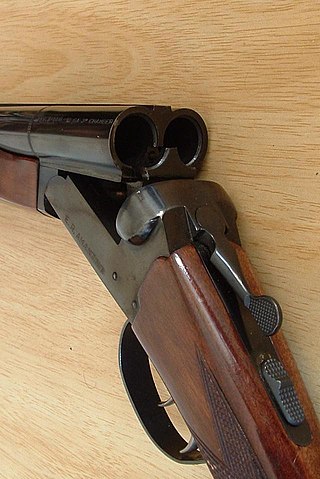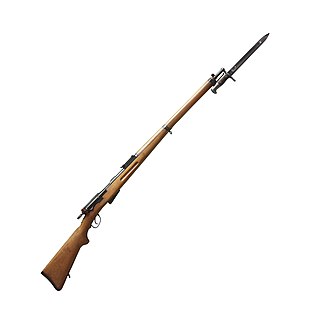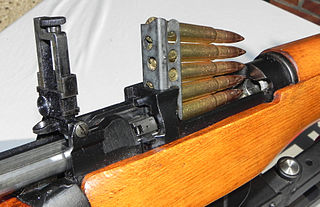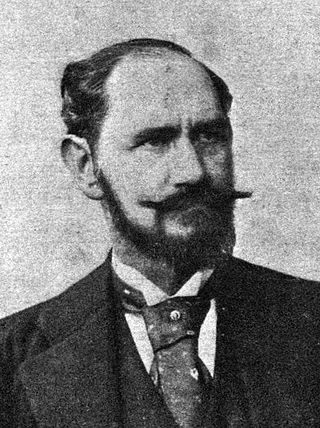
The Krag–Jørgensen is a repeating bolt-action rifle designed by the Norwegians Ole Herman Johannes Krag and Erik Jørgensen in the late 19th century. It was adopted as a standard arm by Norway, Denmark, and the United States. About 300 were delivered to Boer forces of the South African Republic.

A semi-automatic rifle is an autoloading rifle that fires a single cartridge with each pull of the trigger. It uses part of the fired cartridge's energy to eject the case and automatically loads another cartridge into its chamber. This is in contrast to bolt-action rifles, which require the user to cycle the bolt manually before they can fire a second time, and fully automatic rifles which fire continuously until the trigger is released.

In firearms terminology, an action is the functional mechanism of a breech-loading firearm that handles the ammunition cartridges, or the method by which that mechanism works. Actions are technically not present on muzzleloaders, as all those are single-shot firearms with a closed off breech with the powder and projectile manually loaded from the muzzle. Instead, the muzzleloader ignition mechanism is referred to as the lock.
A semi-automatic firearm, also called a self-loading or autoloading firearm, is a repeating firearm whose action mechanism automatically loads a following round of cartridge into the chamber and prepares it for subsequent firing, but requires the shooter to manually actuate the trigger in order to discharge each shot. Typically, this involves the weapon's action utilizing the excess energy released during the preceding shot to unlock and move the bolt, extracting and ejecting the spent cartridge case from the chamber, re-cocking the firing mechanism, and loading a new cartridge into the firing chamber, all without input from the user. To fire again, however, the user must actively release the trigger, and allow it to "reset", before pulling the trigger again to fire off the next round. As a result, each trigger pull only discharges a single round from a semi-automatic weapon, as opposed to a fully automatic weapon, which will shoot continuously as long as the ammunition is replete and the trigger is kept depressed.

The Schmidt–Rubin rifles were a series of Swiss Army service rifles in use between 1889 and 1958. They are distinguished by the straight-pull bolt action invented by Rudolf Schmidt and use Eduard Rubin's GP90 7.5×53.5 and GP11 7.5×55 Schmidt–Rubin rifle cartridge.

A breechblock is the part of the firearm action that closes the breech of a breech loading weapon before or at the moment of firing. It seals the breech and contains the pressure generated by the ignited propellant. Retracting the breechblock allows the chamber to be loaded with a cartridge.

The Mannlicher M1895 is an Austro-Hungarian straight pull bolt-action rifle, designed by Ferdinand Ritter von Mannlicher that used a refined version of his revolutionary straight-pull action bolt, much like the Mannlicher M1890 carbine. It was nicknamed the Ruck-Zuck-[Gewehr] by Austrian troops and "Ta-Pum" by Italian troops who wrote a song (it) about it during World War I. The primary producers were the ŒWG in Steyr, and FÉG in Budapest.
The Mannlicher–Schönauer is a rotary-magazine bolt-action rifle produced by Steyr Mannlicher for the Greek Army in 1903 and later used in small numbers by the Austro-Hungarian Army. Post-war it was sold for civilian use.

A stripper clip is a speedloader that holds several cartridges together in a single unit for easier and faster loading of a firearm magazine.

Ferdinand Ritter von Mannlicher was an Austrian engineer and small arms designer. Along with James Paris Lee, Mannlicher was particularly noted for inventing the en-bloc clip charger-loading box magazine system. Later, while making improvements to other inventors' prototype designs for rotary-feed magazines, Mannlicher, together with his protégé Otto Schönauer, patented a perfected rotary magazine design, the Mannlicher–Schönauer rifle, which was a commercial and military success.
The Karabiner Modell 1931 is a magazine-fed, straight-pull bolt-action rifle. It was the standard-issue rifle of the Swiss armed forces from 1933 until 1958 though examples remained in service into the 1970s. It has a 6-round removable magazine, and is chambered for the 7.5×55mm Swiss Gewehrpatrone 1911 or GP 11, a cartridge with ballistic qualities similar to the 7.62×51mm NATO/.308 Winchester cartridge. Each rifle included a 6-round detachable box magazine with matching stamped serial number. A stripper clip can be used to load the magazine from the top of the receiver.
Steyr Arms is a firearms manufacturer based in Sankt Peter in der Au, Austria. Originally part of Steyr-Daimler-Puch, it became independent when the conglomerate was broken up in 1989. Prior to 1 January 2019, the company was named Steyr Mannlicher AG. In April 2024, the company was acquired by Czech holding RSBC, which owns also Slovenian gun maker Arex Arms.

The FÉG 35M was a bolt-action rifle chambered in 8×56mmR. Though superficially still resembling the 95/31M Carbine, it was a new design with a cock-on-close bolt. An easily recognizable distinguishing feature was the placement of the bolt handle, which was further forward than in the 1895 design. It was used by Hungary in the years leading up to and during World War II, as well as after World War II, yet was gradually phased out by both Red Army surplus, and locally produced Mosin–Nagant carbines in the years after.

The Berthier rifles and carbines were a family of bolt-action small arms in 8mm Lebel, used in the French Army, and French Colonial Forces, from the 1890s to the beginning of World War II (1940). After the introduction of the Lebel rifle in 1886, the French Army wanted a repeating carbine using the same ammunition as the Lebel to replace their single shot carbine based on the Gras rifle. At the time, many armies based their carbines on their standard rifle model, however the Lebel rifle's tube magazine made it difficult to follow this approach. The Modele 1890 Berthier Cavalry Carbine addressed this issue by combining a modified Lebel action with an en-bloc clip magazine. With its successful cavalry introduction, the Berthier would go on to be produced in many different carbine and full-length rifle versions.

Weapons Factory Bern, was an arms manufacturer in Bern, Switzerland, which was a government-owned corporation producing firearms for the Swiss Armed Forces.

The Geweer M. 95, also known to collectors as the Dutch Mannlicher, was the service rifle of the armed forces of the Netherlands between 1895 and 1940 which replaced the obsolete Beaumont-Vitali M1871/88. At first it was produced by Steyr for the Dutch, but after 1904, production took place under license at a Dutch state weapon factory in Zaandam known by the name of close by Hembrug bridge. Although often regarded as being based on the earlier Mannlicher 1893 Model, the rifle is in fact a modification of the Mannlicher rifle by August Schriever and the Dutch rifle commission. The Dutch issued about 470,000 M.95s.

Within military 8 mm firearms, the Repeating Rifle Mannlicher 1888, better known as the Mannlicher M1888, was a bolt-action rifle used by several armies from 1888 to 1945. Derived from the M1885 and later M1886 models, it was Ferdinand Mannlicher's third rifle that utilized the "en bloc clip".

The repeating carbine model 1890 a.k.a. Mannlicher model 1890 carbine is a bolt-action rifle, designed by Ferdinand Mannlicher that used a new version of his straight-pull action bolt. It was introduced as an alternative to the Mannlicher M1888 as it was shorter and easier to maneuver with. Three main versions were introduced: Cavalry Carbine, Gendarmerie Carbine and Navy Short Rifle.

The Repeating Rifle Model 1886, commonly known as Mannlicher Model 1886, was a late 19th-century Austrian straight-pull bolt-action rifle, adopted in 1886. It used a wedge-lock straight pull action bolt. It was the first straight-pull bolt-action service rifle of any nation.

The Mannlicher M1893 is a bolt-action rifle that was the standard service rifle of the Kingdom of Romania from 1893 to 1938. The rifle and its 1892 predecessor were the first repeating rifles to be widely issued in the Romanian military. It was later replaced by the Czechoslovak-designed Vz. 24 as the standard service rifle.

















